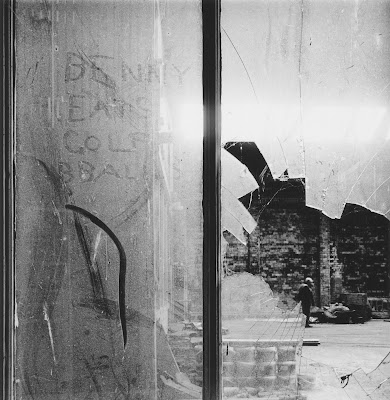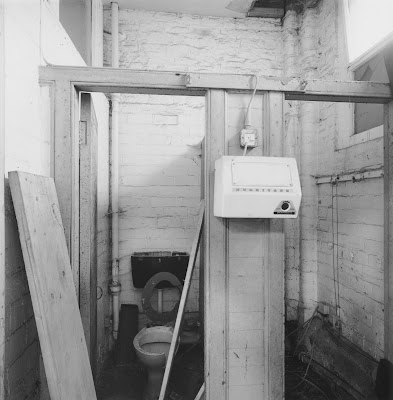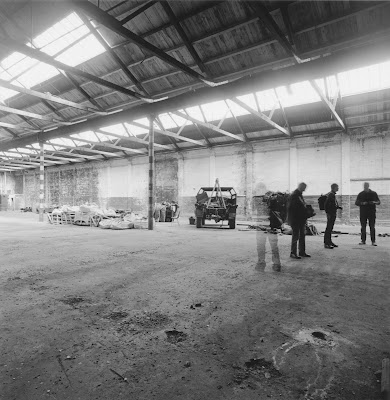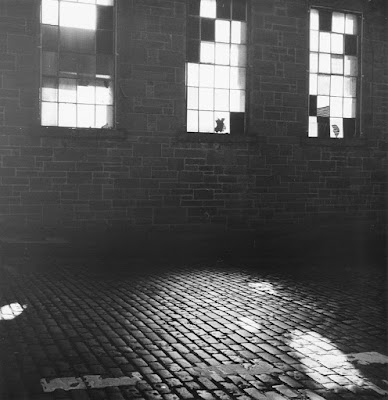Across the evening sky
All the birds are leaving
But how can they know
It's time for them to go?
Before the winter fire
I will still be dreaming
I have no thought of time
For who knows where the time goes?
Who knows where the time goes?
Sad, deserted shore
Your fickle friends are leaving
Ah, but then you know
It's time for them to go
But I will still be here
I have no thought of leaving
I do not count the time
For who knows where the time goes?
Who knows where the time goes?
And I am not alone
While my love is near me
I know it will be so
Until it's time to go
So come the storms of winter
And then the birds in spring again
I have no fear of time
For who knows how my love grows?
And who knows where the time goes?
Morning folks - hope you've got your black jumpsuit on, because today's post is concerned with death and what to do about all the detritus you will inevitably leave behind!
Oh yes, it's a right old morbid smörgåsbord of early morning thinking, confusion, inevitability and good old:
"Feck Me . . I am how old??!! . . but I was ONLY 17 a few years back . . . "
I find it weirdly satisfying in some way that Sandy Denny (writer and singer of the lyrics at the start) had a grandparent who was a Dundonian . . anyway, that's grist for another mill, though I have to say lyrically, with relations and friends embattled by the rigours of life, that song rings to me like a bell on a clear morning.
 |
Taking A Trip In A Caravan
(The sort of image that will never survive. Never printed, just scanned.
Found in the nether-regions of my computer.)
Olympus Trip/Caravan/Autumn/Agfacolor. |
So, my post today concerns photographs and how the hell do you handle them in the event of someone dropping off their perch.
Unfortunately, having re-read it umpteen times, it is largely devoid of advice or ideas and is more a random collection of thoughts about clog poppin'.
"Say wha??"
Well, you can't avoid it, it is going to happen.
You might hide in the corner clutching your head, but somewhere down the line the Grim Reaper is going to camp out in your garden and demand some sort of restitution.
So what do you do?
That's a hard one, because actually I am not sure you can do anything, except prepare as much as you can and then that's it.
The hardware is fine, there's no problems with that - in fact you could really deal with all that stuff in one word . . and no it's not necessarily Ebay, so, got your Ikea meatball meal deal ready?:
Döstädning!
Go on have a laugh at my expense why dontcha.
Ee's off 'is trolly!
The concept is a simple one - you divulge yourself of stuff that might be really useful to someone else down the line (in age).
After all as you get older, stuff becomes a burden - this could be a solution and might make you feel good too. You don't really need 15 Paterson tanks and 8 Kodak Beehives (just in case) do you? That old Meopta enlarger you upgraded from in 1996 and that takes up about two large suitcases worth of space . . surely there's someone out there that could use it as a learning tool. Of course, I know you'll say, well they'll just sell it anyway, to which I would say, fine, let them try and pack it properly!
It's a thought.
I didn't come up with the concept, but I quite like it. In an ideal world, where people weren't trying to squeeze every last penny out of everything, then it could almost be considered utopian.
But that's about getting rid of useful stuff - what about those archival boxes you have filled with your entire photographic output?
I have a friend who has everything - from a first film made on a parent's camera, right the way through to now with 12 mega-terabyte drives (for storage and backup).
But backup for what?
Are his children going to keep all of those drives?
And how do they share it around?
What happens if they were to slim it down to say one and it fails?
And what about the physical stuff - a lifetime of negatives and prints? Are they really going to look through every single photo their father has taken?
It is a massive burden acquiring stuff, but it is an even more massiver burden acquiring custody of someone else's stuff.
So what do you do?
Pretty much without exception, most families are exactly the same - we've got PHYSICAL photographs (yes I know there are exceptions based upon monetary and sociological factors - please bear in mind I am generalising based upon my own experience.)
And it's not just a handful of photographs, no, that would be too easy; it is TONS of them and not only that, but tons of them picturing the most ephemeral and trite things as well.
Boxes (or if you were sensible paper envelopes) filled to the brim with multiple out of focus snaps of birthdays and scenic snaps and a delphinium that your Gran had - the list is as endless as it is incomprehensible why someone took a picture of a squashed cup-cake anyway.
Added to this, I don't think anyone anywhere has gone:
I know we should really curate these because somewhere down the line someone is going to have to go through this.
Though actually that's not quite true - my wife and I kind of did back in the day - the best were stuck in albums, and the remainders and corresponding negatives shoved back into their envelopes and put away somewhere.
But the thing is, they have never gone anywhere and ultimately, they remain as a MASSIVE headache for our progeny, or the next door neighbours when they're wondering what the smell is.
Our (carefully curated remember) albums now occupy a whole large shelf, that will either have to be taken on board, or . . .
My own personal photographic output occupies six CXD archival boxes . . . and that is just the negatives!
When you factor in the print boxes/old paper boxes stuffed with prints, I start to wonder, is my family really going to want to go through all this when they possibly have a whole house to clear?
Or is it more likely the case that they're going to cherry pick.
And the rest? . . . well who knows . . .
When I put it like that it is kind of depressing isn't it?
You start to think, actually is there any point in this?
When my Mother died, my sister and her kids cleared the house.
Living 400-odd miles away and working full time I was unable to help, so consequently, anything from my early life that my Mother still had (it wasn't much, but it was something) got chucked or given away.
There was nothing particularly valuable, it was just sentimental junk.
But that's not the point.
Some things you have with you for years; for instance my copy of Lord Of The Rings was given to me at Christmas, in 1974, and I have read it around 28 times.
It has fallen apart, but now has an ignominious chunk of Japanese framing tape obscuring the lovely spine . . . yet I refuse to give it up in favour of the other very nice editions we have in the house, simply because it is mine and stained with my patina; and, to an extent it is imbued with me.
You could probably call it sentimental junk, but strangely sentimental junk counts for a great deal in the human condition.
But the question is: WHAT IS GOING TO HAPPEN TO IT?
In an ideal world, we'd reach the end of our lives in some sort of psuedo-hippy white room, with little or no possessions (the key thinking being that they are things that tie your soul to the earth) before we are whisked off on The Cosmik VW Space-Combi to Nirvana.
I sort of get that, so chuck the hotdogs on the Bar-B now.
But although we're the stuff of stars, we're also made from the heavy layers of earth and rock and water beneath us; we're as tied to the planet as one could possibly be.
Sure, all thoughts of the soul lifting free and soaring off to some cosmic plane . . well, who knows?
Yet as humans here we are, farting, eating, breeding, contemplating . . and, for want of a better phrase, gaining earthly chains.
Jings, you don't half acquire them don't you?!
In the past few years I've encountered people's hoards, the likes of which the ancients would have considered treasure troves . . but in our modern world of plenty, it is just STUFF.
And it is the autopsical handling of stuff that is the most difficult.
I was recently talking to a neighbour and she said something along the lines of:
"Why worry about it? It won't be your problem. Enjoy it now and let it become someone else's problem."
I can get that.
But I can also get that someone, somewhere will have to deal with it.
It's no surprise that house clearances are so popular - the lure of a Leica IIIg in a box of old towels; a Maserati quietly rusting in a garage . . .
When the time comes and someone has to clean up the remnants of your life, their temptation will be to quickly scout through everything looking for valuables, and the rest . . well the rest will probably just get chucked.
And sadly, for us as photographers, that probably means all our efforts in the form of negatives and prints and hard drives.
Don't worry about the tools . . someone will want the tools; but the form, the architecture of creation; your creative urges writ large . . well, sadly, unless you were well known, then I doubt anyone will give a shit.
So what does one do with thousands of negatives; hundreds of prints; 12 terabytes of digitalness?
I actually don't know.
Are they of any worth?
Only to you my friend, only to you.
Even the great auction houses in the home of serious photography (America) won't take negatives.
They only want vintage prints, and even then I doubt they want the work prints, oh no.
The scrap copy of Moonrise over Hernandez with the giant coffee stain on it . . probably in a pile somewhere . . but a signed edition? well that is a different story.
And a different story in that we're talking about one of the masters.
Old Joe Soap from Wigan or Ohio, or Sienna or Dubrovnik, or Cobh or Beattock . . well fuggedaboutit.
This was hammered home to me recently due to a family thing, whereby I had cause to riffle through a part of my family hoard of snaps that weren't in my house.
There were hundreds of prints all loosely gathered in plastic bags and boxes, flying free from their old printers' envelopes and not a negative in sight.
The shoe boxes I had organised them into some 30 years back with the help of my Mum's memory were nowhere to be seen.
And this was kind of important, because after all, snaps going back 40+ years. . . who remembers who these people were?
That person with the standard lamp shade on their head?
The dog in the cardigan?
A small girl playing at a kitten's tea party in a sunny room somewhere.
The boy/man floating dead in a canal?
Who are they and why are there photographs of them?
Our stabs at immortality in the form of documenting the fleetingness of life through photography (sic) are worth nothing if nobody knows who/what/where/when/you/we/they/are/were and why.
When I put it like that, I kind of wonder is there actually any point in a photograph?
When all you have left is a random image of 'somewhere' or 'someone' and nobody knows where it was or who it was, or even what they were doing . . why document it in the first place?
I need to go and have a big think now, because in the typing of all this, I have asked myself a series of questions I am not comfortable with.
Several weeks and gallons of tea later . . .
 |
Approximately 1949. This recent find hasn't scanned well because of the glazing of the photograph. The print is a contact print. |
 |
Approximately Mid-1940's
Another extraordinary find.
I think the lighting is terrific.
|
So I guess the point of a photograph, is to bring into existence a moment of time that is relevant to you, the photographer (and anyone with you involved in said moment of time).
And that is it (well actually that is partly it.)
When you depart this plane, that moment of time kind of ceases to have any relevance, because everything that was ever behind it is gone.
If you are survived by others in the photograph, then the relevance is still there until they too face the inevitable and shuffle off into The Cosmic Corner.
At that point the photograph carries on existing, but only as evidence of a slice of time with a little relevance.
Like the above two gems (unseen by me until a month ago) it becomes a 'historical' artefact.
However when you look at photos like that, you can see that the life of a photograph isn't quite as dead-end as it might at first appear to be.
But I think that all depends on the subject matter - apart from family photos, this 'historical' relevance might become more important if the photograph is what is now colloquially known as 'street' (or indeed any documentation of the fleetingness of 'modernity'.)
A friend from the Forum (Hi Neil!) has a wonderful collection of snaps from around Dundee in the late 1970's early '80's and they are true historical documents of a City undergoing change and that has largely vanished.
In cases such as that, I think the photograph can live on.
But can it live on when it is (as a huge amount of hobbyist photography appears to be these days) ANOTHER picture of some flowers with massive amounts of bokeh, or ANOTHER woodland, or ANOTHER abandoned building, SOMEWHERE?
I have to say (and I mean no disrespect) that the ease of digital photography in being able to produce, say, fifteen images when just ONE would have sufficed, has resulted in an explosion of truly terrible photography.
Yeah I know, you're saying:
"My Dad used to take loads of horrific pictures of us with his Instamatic"
however in my opinion, it is just too damn easy to make something look 'acceptable' and there is now so much of it (please, check Flickr [look for your favourite lens f'rintance] . . some very good stuff on there, but also a hell of a lot of bilge) that often it is impossible to lift one image out of the morass, because that morass is now so huge, and, dare I say it, so professional looking!
It is almost like trying to fish a floating sweety wrapper that you lost out of the Pacific Gyre.
And, it is all Petabytes of data, just lying around on servers, doing little, and rarely looked at.
My friend can take 300 images in a couple of hours - I doubt (as a film photographer) that I take 300 images in 6 months.
It is stuff, stuff and even more stuff, with little thought to the future, or indeed the environmental impact of such energy usage concerned with storing stuff that nobody will look at!
But back to the meat and potatoes . . can a photograph truly survive in a post-maker environment?
As regular readers will know I love good landscape photography, so here's some thinking about that.
I might say that some of the skill of the truly great landscape photographers is such that their eye and personal deep feeling for landscape somehow imbues the image with something other than it just being a picture of a scene.
(Please note this is entirely different for what passes for most landscape photography today.)
I'd like to call it (loosely) ATMOSPHERE. (Friend Bruce might call it UB [Unsubstantiated Bollocks].)
It can exist in a photograph.
That's not bullshit, I tend to regard that as fact.
And somehow that twilight dust present at the taking of the photograph, sifts its way down through the years after the image was recorded; the photographer's feelings and emotional interaction with the landscape and what they did with the resulting cosmic mess (that is a negative) carries on in a physical form (the print).
So much so that maybe someone, somewhere down the line will look at that print and say:
"Oh!"
and that image will transcend time and come to mean something to another viewer in another place.
That is the happy outcome.
In decades to come, Michael Kenna's or Paul Caponigro's prints, won't just be consigned to the skip of eternity - no way hosepipe.
And what about the records of moments in time?
Well they already have cojones in spades, simply by dint of the fact that they are a recording of a (perhaps important) thing that sprang into being and ended, but someone was there to capture it.
You'll know them by their triumphs and tragedies, yet they live on.
Donald McCullin's photographs will survive any bombardment.
And it's funny, I can still look at a photograph by Clarence H. White and be moved to tears. I've no idea why. Spirituality was important to him, and each photograph, though seemingly 'dull' on the surface carries with it a weight of soul.
His soul.
These are images made over 100 years ago, yet they can still speak. It's weird isn't it?
So I suppose what I am trying to say, is that there is a point to a photograph (phew.)
The above pictures of my parents as young(er) people helped me visualise (along with copious letters) their world. In truth these paper-thin slices of silver gelatin and time moved me to tears.
Somehow they've survived for nearly 80 years without any great care.
To me they have a point.
But is there any point to the mountains of snaps and the general day-to-day picture taking that we (well I can only really talk about me) generally do?
I will often go out and waste and hour or two with my camera taking pictures of the same things I have taken pictures of before.
I do it, because I enjoy the process AND because sometimes I'll develop a film and go "Aha!"
And whilst the Ahas won't win me any awards, they're a reflection of my creativity and creative urges.
But they don't half add up to a pile of pointless stuff that someone else will have to deal with.
My friend Bruce says he'd rather just have a greatest hits left rather than a whole archive.
Books is his big answer, but he has still to make one (not chiding Bruce, btw . . . )
For years I have railed against this, but in reality, his approach is probably pretty sane.
It's something the kids can look at and admire, rather than having to trawl through 20,000+ negatives and go:
"Jeez Dad didn't half take some crappy pictures! What the Feck are we going to do with all this?"
Ah you see, because behind all our endeavours is also the fact that leaving a mountain of stuff behind also means we're loading guilt and angst onto our descendants, who have to decide what to do with it:
"Have you got room for all this?"
"Nope, me neither . . . "
In all my years of writing this blog, I think these are the hardest questions I have ever posed:
WHAT DO WE DO WITH ALL THIS STUFF?
HOW IS IT POSSIBLE TO WINNOW A LIFETIME OF IMAGE MAKING?
SHOULD WE EVEN CARE AND JUST LEAVE IT TO CHANCE?
I really don't know, but I'd love to know your thoughts, because really I think I have only just scratched the surface.
Anyway, the question is out there now.
No doubt (as I've found with some of my articles) some enterprising bod will nick the idea to get some clicks and it will become more of a general question.
And I hope that when you come in to have your card marked, you have some damn good ideas, because frankly I haven't got a clue.
So, answers on a postcard please to:
H. Sheephouse
Sheephouse Towers
Fleeceville
Sheepcestershire
BB1 BB2
If I get a decent response, I'll publish them as a separate post, say in a few weeks time . . . .
Comments can be read on this 'ere link
'ere.
As always thanks for reading.
H xx

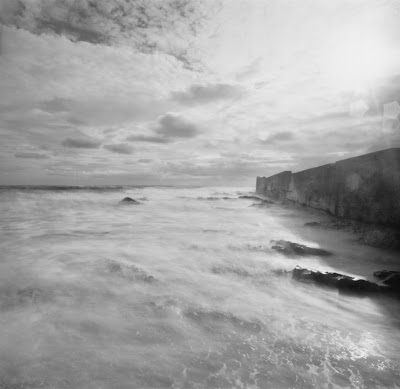
.jpeg)
.jpeg)






